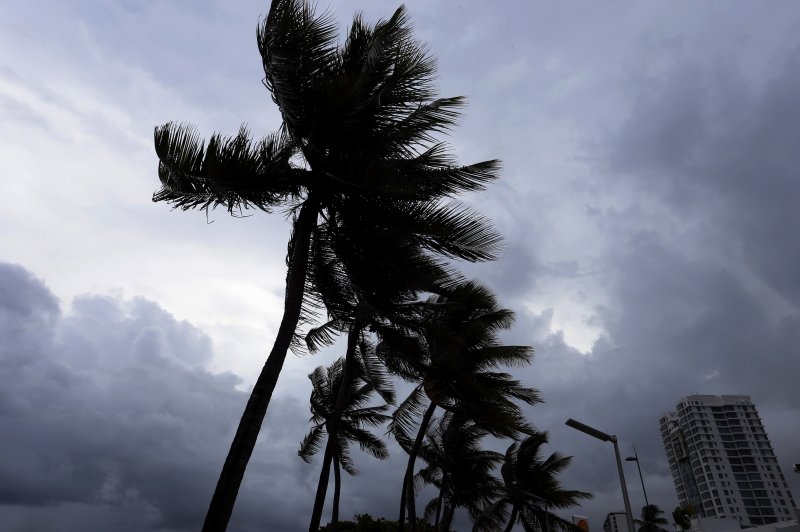Palm trees flutter due to wind and rain in San Juan, Puerto Rico, on Wednesday. Officials said at least three people have died in Barbuda, St. Martin and St. Bart's as Hurricane Irma bore down on the Caribbean. Photo by Thais Llorca/EPA
Sept. 6 (UPI) -- Hurricane Irma killed at least three people in the Caribbean's easternmost islands Wednesday, also tearing roofs off homes and buildings as tens of thousands of residents sought protection from the Category 5 storm.
The hurricane, with maximum sustained winds of 185 mph, hit Antigua and Barbuda early Wednesday before tracking to the French islands of St. Barthelemy -- better known as St. Bart's -- and St. Martin. Two people died in the French islands and one other died in Barbuda, local officials said.
Wednesday evening, Irma was bearing down on Puerto Rico and was projected to next pass near the Dominican Republic.
CNN reported that nearly 900,000 people were without electricity in the island's capital city of San Juan, but no injuries have yet been reported.
The eye of Irma veered north and didn't go over Puerto Rico, but Gov. Ricardo Rosselló said the U.S. territory has experienced "significant damage" from the storm's fierce winds.
Before Antigua lost telephone communication with adjacent Barbuda, the Barbuda Weather Station reported sustained winds of 119 mph and gusts of 150 mph.
There are widespread reports of heavy damage, including that of Barbuda's police station. Numerous trees and telephone poles were also toppled, and wind gusts of 156 mph broke some of the country's weather-monitoring equipment.
Barbuda is home to about 1,600 people, who mostly live near the sea-level city of Codrington. They are wary of storm surges, with Barbuda's highest elevation being 150 feet.
"We have a lot of broken trees across the island," Keithley Meade, director of a meteorological office in Antigua, told CNN.
Irma destroyed four government buildings on the French-administered portion of nearby St. Martin, an island of about 75,000 people, French Interior Minister Gerard Collomb said Wednesday in Paris.
President Donald Trump owns an 11-bedroom waterfront estate in St. Martin on part of the island under French government jurisdiction. It's part of a trust and is listed for sale for $16.9 million. No specific damage to his property was reported but that part of the island was seriously damaged, according to French officials.
Prime Minister Timothy Harris of St. Kitts and Nevis, the next country on Irma's westward track, announced that all its "national security agencies have been fully mobilized and are the highest alert."
The island's police commissioner, Ian Queeley, said the situation was "not too bad. Still plenty rain and strong winds" in a text message.
The storm also passed near the British Virgin Islands and northern U.S. Virgin Islands later Wednesday. U.S. Virgin Islands Gov. Kenneth E. Mapp ordered a 36-hour curfew that started at 6 a.m.
By Wednesday night, the storm's center is expected to pass near or just north of Puerto Rico, a U.S. territory in the midst of an economic recession with little ability to pay for rebuilding.
Puerto Rico Gov. Ricardo Rossello, who declared a state of emergency and has activated the National Guard, warned residents Wednesday that between 8 and 12 inches of rain were expected as the hurricane moves westward.
Officials said remote parts of the island might not have electricity for up to eight months.
By Thursday and Friday, Irma is likely to be near the Dominican Republic and Haiti's northern coasts, the Turks and Caicos islands and the southeastern Bahamas, the hurricane center said.
The NHC called the hurricane "potentially catastrophic" and issued warnings for Antigua, Barbuda, Anguilla, Montserrat, St Kitts and Nevis, Saba, St. Eustatius and Sint Maarten, St. Martin and St. Barthelemy, the British Virgin Islands and the U.S. Virgin Islands, Puerto Rico, Vieques and Culebra, the Dominican Republic and Guadalupe.
The hurricane was on track to turn north and hit Florida by the weekend.
"I am at a complete and utter loss for words looking at Irma's appearance on satellite imagery," NHC scientist Taylor Trogdon posted on Twitter.















